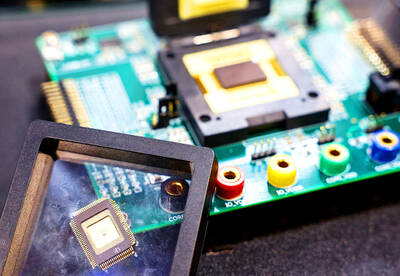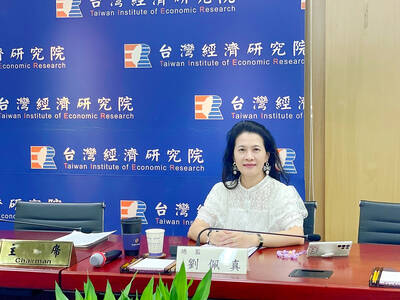Plans by South Korea’s SK Hynix Inc to overhaul a huge facility in China so it can make memory chips more efficiently are in jeopardy, sources familiar with the matter told Reuters, because US officials do not want advanced equipment used in the process to enter into China.
The potential setback could make SK Hynix, one of the world’s biggest suppliers of DRAM memory chips that go into everything from smartphones to data centers, the next victim of the geopolitical struggle between the US and China.
SK Hynix production plans call for the company to upgrade a mass production facility in Wuxi, China, with some of the latest extreme ultraviolet lithography (EUV) chipmaking machines made by Dutch firm ASML Holding NV, three people with knowledge of the matter said.

Photo: Reuters
The US in the past has objected on the grounds that shipping such advanced tools to China could be used to strengthen the country’s military.
The Wuxi factory is critical to the global electronics industry because it makes about half of SK Hynix’s DRAM chips, which amounts to 15 percent of the worldwide total.
Any major changes could have an impact on global memory markets, where analyst firm IDC Corp says demand is growing at 19 percent this year alone.
As newer styles of chips make up a greater share of SK Hynix’s production in two to three years, the company will need the EUV machines to control its costs and accelerate production, a source with knowledge of the company’s operations in China said.
The extent of the concerns inside of SK Hynix has not been previously reported.
If the situation is not resolved in the next several years, SK Hynix could stand at a disadvantage against rivals, such as No. 1 memory chipmaker Samsung Electronics Co and the US’ Micron Technology Inc.
Samsung and Micron are also shifting to ASML’s EUV machines, but are not using them at factory locations where the machines face export restrictions.
The question of the ASML machines has drawn enough concern within SK Hynix that chief executive Lee Seok-hee raised the issue with US officials during a visit to Washington in July, two people briefed on his visit said.
SK Hynix declined to comment on the matter, adding that it operates flexibly according to various market environments and is doing its best to respond to market and customer demands without issue.
An ASML spokesperson said that the company abides by all export control laws and views them as a “valid tool” for governments to ensure national security.
However, the company said the overuse of those controls “might impact the production capacity needed to stay ahead of the increasing demand of semiconductors.”
“It is likely that widespread use of export controls could exacerbate microchip supply chain issues, which are already a major concern of governments and policy makers around the world because of the spill-over effect to other industries,” such as the automotive industry, the spokesperson said in a statement.
Analysts do not believe that US officials would view SK Hynix’s efforts to bring an EUV tool into China any differently than earlier efforts by Chinese firms.
“They’re really caught between a Chinese rock and a US hard spot,” VLSIresearch chief executive Dan Hutcheson said, adding that the rules would likely apply to any chip manufacturing operations in China, foreign or domestically controlled.
“Anyone who puts an EUV tool in China gives China the capacity,” he said.
“Once it’s there, you have no idea where it will go after that. The Chinese could always seize it or do whatever they wanted to do,” he said.

IN THE AIR: While most companies said they were committed to North American operations, some added that production and costs would depend on the outcome of a US trade probe Leading local contract electronics makers Wistron Corp (緯創), Quanta Computer Inc (廣達), Inventec Corp (英業達) and Compal Electronics Inc (仁寶) are to maintain their North American expansion plans, despite Washington’s 20 percent tariff on Taiwanese goods. Wistron said it has long maintained a presence in the US, while distributing production across Taiwan, North America, Southeast Asia and Europe. The company is in talks with customers to align capacity with their site preferences, a company official told the Taipei Times by telephone on Friday. The company is still in talks with clients over who would bear the tariff costs, with the outcome pending further

NEGOTIATIONS: Semiconductors play an outsized role in Taiwan’s industrial and economic development and are a major driver of the Taiwan-US trade imbalance With US President Donald Trump threatening to impose tariffs on semiconductors, Taiwan is expected to face a significant challenge, as information and communications technology (ICT) products account for more than 70 percent of its exports to the US, Chung-Hua Institution for Economic Research (CIER, 中華經濟研究院) president Lien Hsien-ming (連賢明) said on Friday. Compared with other countries, semiconductors play a disproportionately large role in Taiwan’s industrial and economic development, Lien said. As the sixth-largest contributor to the US trade deficit, Taiwan recorded a US$73.9 billion trade surplus with the US last year — up from US$47.8 billion in 2023 — driven by strong

A proposed 100 percent tariff on chip imports announced by US President Donald Trump could shift more of Taiwan’s semiconductor production overseas, a Taiwan Institute of Economic Research (TIER) researcher said yesterday. Trump’s tariff policy will accelerate the global semiconductor industry’s pace to establish roots in the US, leading to higher supply chain costs and ultimately raising prices of consumer electronics and creating uncertainty for future market demand, Arisa Liu (劉佩真) at the institute’s Taiwan Industry Economics Database said in a telephone interview. Trump’s move signals his intention to "restore the glory of the US semiconductor industry," Liu noted, saying that

AI: Softbank’s stake increases in Nvidia and TSMC reflect Masayoshi Son’s effort to gain a foothold in key nodes of the AI value chain, from chip design to data infrastructure Softbank Group Corp is building up stakes in Nvidia Corp and Taiwan Semiconductor Manufacturing Co (TSMC, 台積電), the latest reflection of founder Masayoshi Son’s focus on the tools and hardware underpinning artificial intelligence (AI). The Japanese technology investor raised its stake in Nvidia to about US$3 billion by the end of March, up from US$1 billion in the prior quarter, regulatory filings showed. It bought about US$330 million worth of TSMC shares and US$170 million in Oracle Corp, they showed. Softbank’s signature Vision Fund has also monetized almost US$2 billion of public and private assets in the first half of this year,